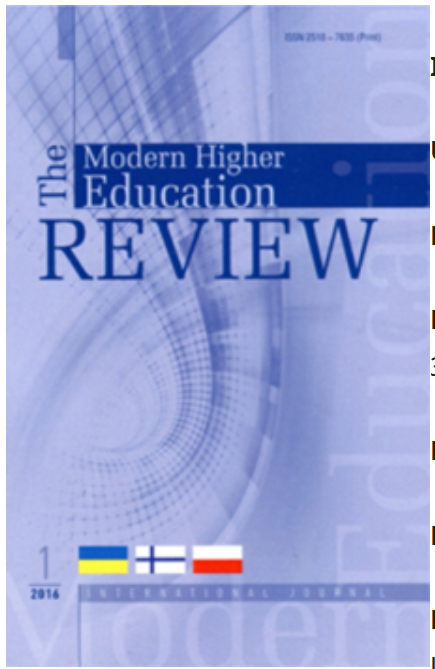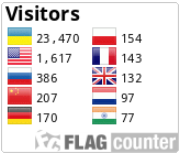DIFFERENTIATED INSTRUCTION AT HIGHER EDUCATION INSTITUTIONS: BIBLIOMETRIC ANALYSIS
DOI:
https://doi.org/10.28925/2617-5266/2024.96Keywords:
differentiated instruction, higher education, higher education institution, bibliometric analysis, Bibliometrix, BiblioshinyAbstract
The article examines the implementation of differentiated instruction in higher education institutions through bibliometric analysis using Scopus database data and Bibliometrix software. Differentiated instruction addresses diverse student needs, interests, and capabilities, aligning with global educational trends emphasizing flexibility, inclusivity, and lifelong learning. Historically focused on special and gifted education, recent studies highlight its broader applications, including STEM, language learning, and online education. The analysis includes 129 relevant publications, representing 13% of all differentiated instruction related research in Scopus. The main areas in the research topic are foreign language teaching, inclusive education, innovative pedagogies, and teacher training. Prominent trends include the integration of differentiated instruction in technology-enhanced learning, its impact on student engagement and academic performance, and its role in fostering inclusivity and equity. The study underscores the necessity of teacher readiness and training to implement differentiated instruction effectively. By mapping current knowledge and identifying gaps, the article provides a foundation for advancing differentiated instruction practices in higher education institutions, emphasizing its potential to enhance student outcomes and educational equity in a digitalised context.
Downloads
References
Altemueller, L., & Lindquist, C. (2017). Flipped classroom instruction for inclusive learning. British Journal of Special Education, 44(3), 341-358. https://doi.org/10.1111/1467-8578.12177
AM, M. A., Hadi, S., & Istiyono, E. (2023). Trend research mapping of differentiated instruction: A bibliometric analysis. Journal of Pedagogical Research, 7(3), 194-210. https://doi.org/10.33902/JPR.202320544
Attachoo, B., Imsa-ard, P. (2024). Illuminating Inclusive Pedagogy in Thai EFL Classrooms: Critical Perspectives and Practices in Higher Education. 3L: Language, Linguistics, Literature, 30(3), pp. 229–245. http://dx.doi.org/10.17576/3L-2024-3003-16
Au-Yong Oliveira, M., Walter, C. & Mangiatordi, A. (2022). Seeking Differentiated Instruction in Higher Education: An Analysis of the Literature. European Conference on Research Methodology for Business and Management Studies. http://dx.doi.org/21. 10.34190/ecrm.21.1.417.
Balchin, K. & Bouzaki, F. (2022) Using Instructional Technologies to Cater for Individual Learner Differences. International Journal of TESOL Studies (2022) Vol. 4 (3) 111-124 https://doi.org/10.46451/ijts.2022.03.09
Bi, M., Letzel-Alt, V., Pozas, M., Zhu, C., & Struyven, K. (2024). Chinese version of the teachers’ attitudes towards differentiated instruction scale: an adaptation study. Cogent Education, 11(1). https://doi.org/10.1080/2331186X.2024.2380166
Boelens, R., Voet, M., & De Wever, B. (2018). The design of blended learning in response to student diversity in higher education: Instructors’ views and use of differentiated instruction in blended learning. Computers & Education, Volume 120, Pages 197-212, ISSN 0360-1315, https://doi.org/10.1016/j.compedu.2018.02.009
Chiang, F.-K., & Wu, Z. (2021). Flipping a classroom with a three-stage collaborative instructional model (3-CI) for graduate students. Australasian Journal of Educational Technology, 37(4), 51–67. https://doi.org/10.14742/ajet.6330
Chua, N.A., Embong, A.M., Kadhim, K.A., Ismail, R., Ismail, I.L.M., Soon, G.Y., Baharuddin, S.‘A., Nasir, M.A.M.M., & Salaebing, M. (2024). The belief of Mandarin foreign language educators in differentiated instruction based on student characteristics. International Journal of Sustainable Development and Planning, Vol. 19, No. 2, pp. 629-635. https://doi.org/10.18280/ijsdp.19022
Educause (2023). 2023 EDUCAUSE Horizon Report. Teaching and Learning Edition. https://library.educause.edu/-/media/files/library/2023/4/2023hrteachinglearning.pdf
Elyas, T., AlHashmi, B., & Fang, F. (2020). Cognitive diversity among EFL learners: implications for teaching in higher education. TEFLIN Journal, 31(1), 44–69. https://doi.org/10.15639/teflinjournal.v31i1/44-69
Estaiteyeh, M., & DeCoito, I. (2023) Planning for Differentiated Instruction: Empowering Teacher Candidates in STEM Education. Can. J. Sci. Math. Techn. Educ. 23, 5–26. https://doi.org/10.1007/s42330-023-00270-5
Gebremeskel, T. A., Bachore, M. M., & Bushisho, E. W. (2024). The effects of multiple intelligence based reading tasks on EFL students reading skills achievements: The case of university students in Ethiopia, Heliyon, Volume 10, Issue 13, ISSN 2405-8440, https://doi.org/10.1016/j.heliyon.2024.e33591.
Hernandez, A. M., Daoud, A., Woodcock, A., & Landin, K. (2023). Examining Field Experiences of Teacher Candidates During COVID-19: Systemic Inequities Unveiled for Underserved English Learners in K-12 Grades. Journal of Hispanic Higher Education, 22(3), 307-324. https://doi.org/10.1177/15381927211057764
Kohnke, L., & Moorhouse, B. L. (2022). Higher education instructors inclusive design practices during COVID-19: A Hong Kong perspective. In R. Sharpe, S. Bennett, & T. Varga-Atkins (Eds.), Handbook of digital higher education: Elgar handbooks in education (pp. 135-147). Cheltenham: Edward Elgar Publishing Limited.
Krishan, I. Q., & Al-rsa’i, M. S. (2023). The effect of technology-oriented differentiated instruction on motivation to learn science. International Journal of Instruction, 16(1), 961-982. https://doi.org/10.29333/iji.2023.16153a
Kupchyk, L., & Litvinchuk, A. (2020). Differentiated instruction in English learning, teaching and assessment in non-language universities. Advanced Education, 7(15), 89–96. https://doi.org/10.20535/2410-8286.168585
Kwan P., Kadel R., Memon T.D., & Hashmi S.S. (2024) Intensifying learner engagement and focus by a block mode flipped learning pedagogy. Flipped Classrooms and Learning: Perspectives, Opportunities and Challenges, pp. 9 -33 https://www.scopus.com/inward/record.uri?eid=2-s2.0-85198042619&partnerID=40&md5=b5d612d7cae4ffaba3357a7a121a4b45
Liou, R., Cheng, Y., Chu, P., Chang, H., & Liu, C. (2023). Effectiveness of differentiated instruction on learning outcomes and learning satisfaction in the evidence-based nursing course: Empirical research quantitative. Nursing Open, 10(10), 6794-6807. https://doi.org/10.1002/nop2.1926
Meşe, E., & Mede, E. (2022). Using digital differentiation to improve EFL achievement and self-regulation of tertiary learners: the Turkish context. Innovation in Language Learning and Teaching, 17(2), 340–353. https://doi.org/10.1080/17501229.2022.2043872
Ministry of Education and Science of Ukraine (2023). Візія майбутнього освіти і науки України [Vision of the future of education and science in Ukraine] https://mon.gov.ua/storage/app/media/Viziya.maybutnoho.osvity.i.nauky.Ukrayiny/12.07.2023/Viziya.maybutnoho.osvity.i.nauky.Ukrayiny-12.07.2023-2.1.pdf
Moallemi, R. (2024). The relationship between differentiated instruction and learner levels of engagement at university. Journal of Research in Innovative Teaching & Learning, Vol. 17 No. 1, pp. 21-46. https://doi.org/10.1108/JRIT-07-2022-0041
Nketsia, W., Opoku, M.P., Amponteng, M., & Mprah, W.K. (2024). Exploring the perceived knowledge of teacher educators and pre-service teachers on the differentiated instruction practices of teacher educators. Front. Educ. 9:1356675. https://doi.org/10.3389/feduc.2024.1356675
Obrovská, J., Svojanovský, P., Kratochvílová, J., Lojdová, K., Tůma, F., & Vlčková, K. (2023). Promises and challenges of differentiated instruction as pre-service teachers learn to address pupil diversity. Journal of Education for Teaching, 50(3), 403–420. https://doi.org/10.1080/02607476.2023.2247356
Onyishi, C.N., Sefotho, M.M. (2020). Teachers’ perspectives on the use of differentiated instruction in inclusive classrooms: Implication for teacher education. International Journal of Higher Education, 9 (6), pp. 136-150. https://doi.org/10.5430/ijhe.v9n6p136
Palahicky, S. (2015). Utilizing Learning Management System (LMS) Tools to Achieve Differentiated Instruction. In J. Keengwe & J. Agamba (Eds.), Models for Improving and Optimizing Online and Blended Learning in Higher Education (pp. 12-33). IGI Global Scientific Publishing. https://doi.org/10.4018/978-1-4666-6280-3.ch002
Rafi, F., & Pourdana, N. (2023). E-diagnostic assessment of collaborative and individual oral tiered task performance in differentiated second language instruction framework. Lang Test Asia 13, 6. https://doi.org/10.1186/s40468-023-00223-7
Şaban, C., & Atay, D. (2023). Differentiated Instruction in Higher Education EFL Classrooms: Instructors' Perceived Practices in a Turkish Context. Mextesol Journal, 47 (2). http://www.mextesol.net/journal/public/files/33b71d7ca3deebe5e8ed34b41b4fe3d2.pdf
Sangermán Jiménez, M. A., & Ponce, P. (2021). Differentiated Teaching Based on Standardized Metrics Integrating Fuzzy Logic Type 2 Detection Theory: High School Case-PrepaTec, Mexico. Future Internet, 13(4), 98. https://doi.org/10.3390/fi13040098
Sarzhanova, G., Otynshiyeva, M., Tleuzhanova, G., Assanova, D., & Sadvakassova, A. (2023). Organizational, technological, and pedagogical conditions for differentiated instruction of teaching English as a foreign language. International Journal of Education in Mathematics, Science, and Technology (IJEMST), 11(1), 74-95. https://doi.org/10.46328/ijemst.2809
Shareefa, M., & Moosa, V. (2020). The most-cited educational research publications on differentiated instruction: A bibliometric analysis. European Journal of Educational Research, 9(1), 331-349. https://doi.org/10.12973/eu-jer.9.1.331
Sun, Y., & Xiao, L. (2021). Research trends and hotspots of differentiated instruction over the past two decades (2000-2020): a bibliometric analysis. Educational Studies, 50(2), 186–202. https://doi.org/10.1080/03055698.2021.1937945
Synekop, O. (2020). Regulation aspect of learners’ language learning style in differentiated ESP instruction. Advanced Education, 7(15), 25–31. https://doi.org/10.20535/2410-8286.201978
Synekop O. (2020). Webquest as technology of differentiated ESP instruction at university level. Journal of Teaching English for Specific and Academic Purposes, 8 (1 Special Issue), pp. 43 - 52
https://doi.org/10.22190/JTESAP2001043S
Utami, A., Sujarwo, Fauziyah, P. Y., Mustadi, A., Hidayat, R., & Rofiki, I. (2024). Bibliometric analysis of research developments on differentiated instruction. European Journal of Educational Research, 13(3), 1421-1439. https://doi.org/10.12973/eu-jer.13.3.1421
Wang, Q., & Su, M. (2020). Integrating blockchain technology into the energy sector – from theory of blockchain to research and application of energy blockchain. Computer Science Review, 37. https://doi.org/10.1016/j.cosrev.2020.100275.
Published
How to Cite
Issue
Section
License
Copyright (c) 2024 The Modern Higher Education Review

This work is licensed under a Creative Commons Attribution-NonCommercial 4.0 International License.













